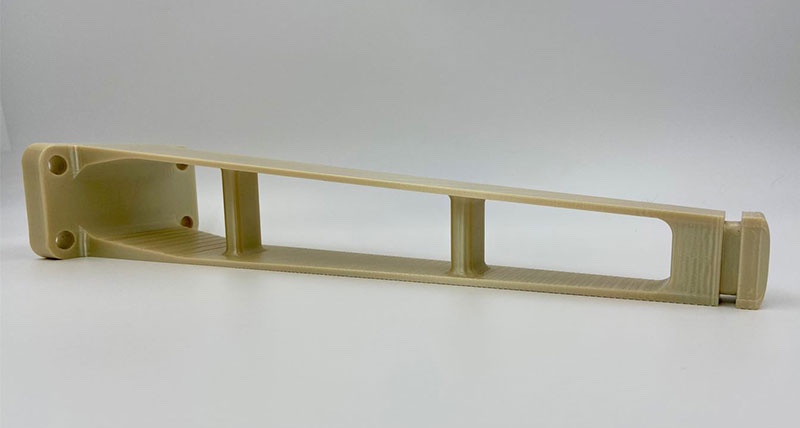One of the world’s most prominent intelligent manufacturing software firms, Hexagon Manufacturing Intelligence, has announced a new partnership with Stratasys, an industry leader in producing 3D printers and solutions for additive manufacturing. The partnership combines Hexagon’s Digimat software with Stratasys’ ULTEM™ 9085 filament, though it’s not the first time Stratasys has used the Digimat material modeling platform. The combination of Digimat and ULTEM 9085 is intended to be used in the production of aircraft cabin interiors—including bracketry, pieces for cable routing, covers, and duct components—as well as cosmetic aircraft interiors.
In a press release, Hexagon and Stratasys predict that, “Through the virtual engineering and manufacturing support provided by the partnership, customers will be able to reduce a two-to-three-year timescale of designing and testing a part to six-to-nine months.”

Hexagon and Stratasys’ new partnership will be used for plastic-derived aircraft cabin components like this one.
Considerations of production lead-time are more important for aerospace than perhaps any other industry. The main reasons for this, historically, have involved the uniquely complex safety regulations involved in producing airplanes, intertwining with the similarly singular difficulties for aircraft manufacturers in proving that their products meet these strict industry standards. In short, the aircraft industry’s main duty is to prove that safety is paramount in the design and manufacture process of their enormous, complicated, expensive machines; and this requires constant research, investment, and retooling.
Additionally, however, the supply-chain disruptions that are only now coming to the fore in global news discourse — but which have been mounting for years — have been especially detrimental to the aerospace industry, which has increased in competitiveness over the last decade faster than ever before. Long before the pandemic exacerbated the problems, a February 2019 article pointed out that:
“Constrained materials and long lead times for critical parts plague the industry. Lead times on some parts have gone from 26 weeks to more than 50, seemingly overnight. Too often, notices of delays from supply chain partners come without warning, and that one hiccup creates a domino effect that delays deliveries all the way to the aircraft integrator.”
With gargantuan expenditures and minuscule profit margins, planning at every stage of the production process is indispensable for the aerospace industry. This has made manufacturers ever more reliant on simulation software and intelligent manufacturing to help them predict exactly what kind of parts they’ll need, how many they’ll need, and when they’ll need them. So far, this has mostly affected metal 3D printing, at least regarding the production of aircraft.
The fact that Hexagon and Stratasys will now be using the same design model in plastics, according to the head of Hexagon’s Manufacturing Intelligence Division, Guillaume Boisot, “…will help compress the design and testing phases and improve understanding of plastic behaviour and speed up innovation across the sector.”
If a solution like this can truly cut production lead-time down to a third of its current length without sacrificing safety or performance, it will eventually change the economics of the entire aircraft industry. Not only will it accelerate the time between the research phase and manufacturing, but it will also greatly enhance manufacturers’ ability to schedule purchases based on real-time data, as well as making it easier to produce on a smaller scale without hurting profit margins. And, above all else, it will integrate production processes across the entire industry. The higher the proportion of metal aircraft components that are produced using 3D printing, the more important it will be for all other sectors involved in aerospace to keep up with the industry’s evolution.
(Images courtesy of Hexagon)
Subscribe to Our Email Newsletter
Stay up-to-date on all the latest news from the 3D printing industry and receive information and offers from third party vendors.
You May Also Like
HILOS Launches Studio OS for AI-Driven 3D Printed Shoe Design
At Milan Design Week, footwear 3D printing startup HILOS has unveiled its latest development, Studio OS. Introduced at the historical Villa Bagatti Valsecchi, the platform is meant to redefine how...
3D Printing Webinar and Event Roundup: April 28, 2024
In this week’s 3D Printing Webinar and Event Roundup, the Ceramics Expo is taking place in Michigan, Stratasys continues its advanced training courses, and SPE is holding a Polymer Characterization...
Initial Speakers and Sponsors Announced for Additive Manufacturing Strategies 2025
Nearly a year away from the event, the Additive Manufacturing Strategies (AMS) 2025 conference is already beginning to take shape. Building upon the success of 2024’s summit, AMS has established...
HP & INDO-MIM Collaborate to Boost Metal 3D Printing in India
HP Inc. and INDO-MIM, a US- and India-based supplier of metal injection molding (MIM) powders and contract manufacturer, have announced that the two companies will collaborate to accelerate additive manufacturing...
































